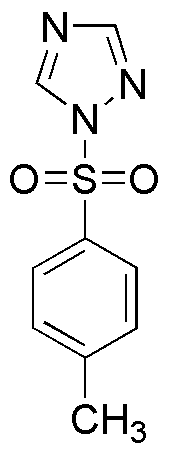1-(p-Toluenesulfonyl)-1,2,4-triazole is widely utilized in research focused on:
- Agricultural Chemistry: This compound serves as a key intermediate in the synthesis of fungicides, helping to protect crops from fungal diseases and improve agricultural yields.
- Pharmaceutical Development: It is used in the creation of various pharmaceutical agents, particularly in the development of anti-inflammatory and antifungal medications, offering targeted therapeutic effects.
- Material Science: The compound is incorporated into polymers and coatings to enhance their chemical resistance and durability, making it valuable in the production of high-performance materials.
- Analytical Chemistry: It acts as a reagent in analytical methods for detecting and quantifying specific compounds, aiding researchers in environmental monitoring and quality control.
- Biochemistry: This chemical is utilized in biochemical assays and studies, particularly in the investigation of enzyme activities and metabolic pathways, providing insights into biological processes.
General Information
Properties
Safety and Regulations
Applications
1-(p-Toluenesulfonyl)-1,2,4-triazole is widely utilized in research focused on:
- Agricultural Chemistry: This compound serves as a key intermediate in the synthesis of fungicides, helping to protect crops from fungal diseases and improve agricultural yields.
- Pharmaceutical Development: It is used in the creation of various pharmaceutical agents, particularly in the development of anti-inflammatory and antifungal medications, offering targeted therapeutic effects.
- Material Science: The compound is incorporated into polymers and coatings to enhance their chemical resistance and durability, making it valuable in the production of high-performance materials.
- Analytical Chemistry: It acts as a reagent in analytical methods for detecting and quantifying specific compounds, aiding researchers in environmental monitoring and quality control.
- Biochemistry: This chemical is utilized in biochemical assays and studies, particularly in the investigation of enzyme activities and metabolic pathways, providing insights into biological processes.
Documents
Safety Data Sheets (SDS)
The SDS provides comprehensive safety information on handling, storage, and disposal of the product.
Product Specification (PS)
The PS provides a comprehensive breakdown of the product’s properties, including chemical composition, physical state, purity, and storage requirements. It also details acceptable quality ranges and the product's intended applications.
Certificates of Analysis (COA)
Search for Certificates of Analysis (COA) by entering the products Lot Number. Lot and Batch Numbers can be found on a product’s label following the words ‘Lot’ or ‘Batch’.
*Catalog Number
*Lot Number
Certificates Of Origin (COO)
This COO confirms the country where the product was manufactured, and also details the materials and components used in it and whether it is derived from natural, synthetic, or other specific sources. This certificate may be required for customs, trade, and regulatory compliance.
*Catalog Number
*Lot Number
Safety Data Sheets (SDS)
The SDS provides comprehensive safety information on handling, storage, and disposal of the product.
DownloadProduct Specification (PS)
The PS provides a comprehensive breakdown of the product’s properties, including chemical composition, physical state, purity, and storage requirements. It also details acceptable quality ranges and the product's intended applications.
DownloadCertificates of Analysis (COA)
Search for Certificates of Analysis (COA) by entering the products Lot Number. Lot and Batch Numbers can be found on a product’s label following the words ‘Lot’ or ‘Batch’.
*Catalog Number
*Lot Number
Certificates Of Origin (COO)
This COO confirms the country where the product was manufactured, and also details the materials and components used in it and whether it is derived from natural, synthetic, or other specific sources. This certificate may be required for customs, trade, and regulatory compliance.


